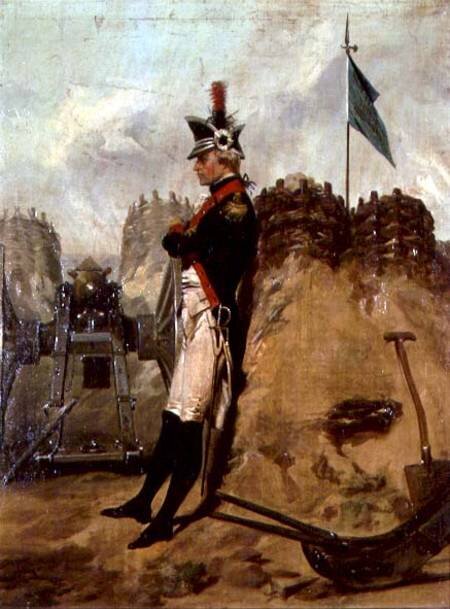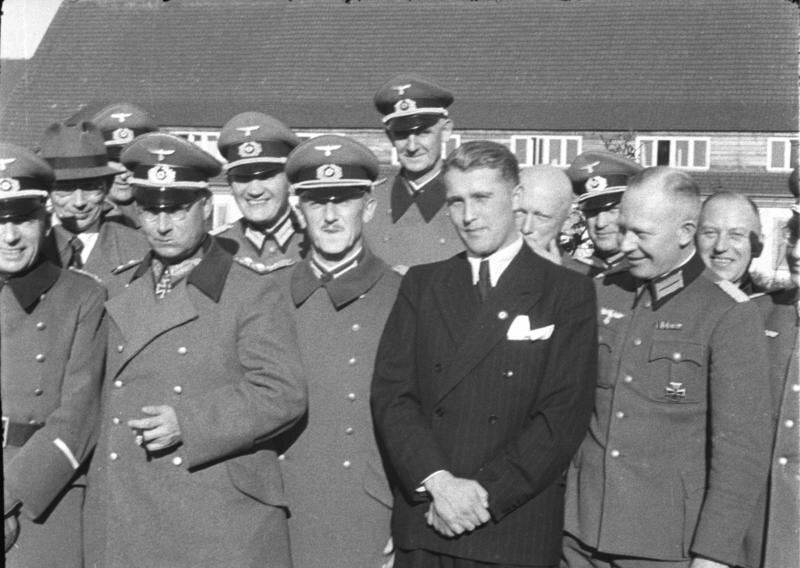Wernher von Braun came to America from Germany after World War II as part of Operation Paperclip. He went on to play a major role in the Cold War’s Space Race with his expertise of rockets. However, views of von Braun are being reassessed as the terrible role he played in Nazi Germany has come to the fore in recent years. Victor Gamma looks at von Braun’s beliefs and how much responsibility he needs to take for Nazi atrocities below.
Read part 1 on Von Braun’s life here, and part 2 on the evidence here.
Von Braun with Fritz Todt, who used forced labor across the parts of Europe occupied by the Nazis. Von Braun is wearing the Nazi party badge on his suit lapel. Source: Bundesarchiv, Bild 146-1978-Anh.023-02 / CC-BY-SA 3.0, available here.
What about the photos of him wearing a swastika badge or an SS uniform? This does not prove he was an ideological Nazi either. The nature of the regime meant that gestures of at least outward loyalty must be performed. That is a characteristic of a dictatorship. During the Third Reich many people joined the Nazi party for a variety of reasons, some of which had nothing to do with loyalty to party ideology. For instance, the stellar economic performance of the Hitler regime motivated many to support Hitler and join the National Socialist party organization in some capacity. The evidence is fairly clear that this was the case with von Braun. Witnesses testify that he wore the SS uniform on certain occasions when it was required or expedient to do so and no more. In the last years of the war, Hitler grew increasingly paranoid. More and more, he only trusted those “tried and true National Socialists,” such as the SS. The wearing of the SS uniform meant protection for the wearer. Von Braun, having been arrested once, could not give Himmler any excuse to do so again.
The accusation of von Braun as an amoral sycophant devoid of any moral sense does not entirely hold up either. A more accurate view, based on numerous eyewitness testimonies and an understanding of the era, is that von Braun, like so many Germans, did not foresee the extent of the atrocities that would take place, and, once aware they were happening, overlooked them. Nonetheless, at least some of his decisions were at least partially motivated by ethical concerns. When it came time, at the end of the war, to decide which side deserved his rocket secrets, he employed moral reasoning hostile to the atheistic communist regime of Stalin. Commenting on his surrendering to the Americans in May 1945, von Braun stated:
We knew that we had created a new means of warfare, and the question as to what nation, to what victorious nation we were willing to entrust this brainchild of ours was a moral decision more than anything else. We wanted to see the world spared another conflict such as Germany had just been through, and we felt that only by surrendering such a weapon to people who are guided not by the laws of materialism but by Christianity and humanity could such an assurance to the world be best secured.
A study of von Braun’s life reveals that these sentiments reflect a developing personal moral viewpoint that evolved into a strong and fully formed religious belief system in subsequent years. Over time he progressed from a relatively irreligious technician to a man of deep and abiding faith. As director of America’s space effort he stated, "In this age of space flight, when we use the modern tools of science to advance into new regions of human activity, the Bible - this grandiose, stirring history of the gradual revelation and unfolding of the moral law - remains in every way an up-to-date book.” The above quotes are just two of dozens by von Braun.
Additionally, evidence shows plainly that the great rocketeer warmly embraced not only American citizenship but also American values. In April 1955, von Braun and his fellow German scientists became American citizens. Von Braun told the press at the time, “This is the happiest and most significant day in my life. I must say we all became American citizens in our hearts long ago.” By that time, Dr. von Braun’s personal convictions and worldview were antithetical to both the official paganism of the Nazi state or the official atheism of the Soviet Union. Wernher von Braun summed up his philosophy as follows: “The ethical guidelines of religion are the bonds that can hold our civilization together. Without them man can never attain that cherished goal of lasting peace with himself, his God, and his fellowman."
Just how Guilty?
Nonetheless, we cannot completely excuse von Braun from his involvement to some extent with atrocities, even if indirectly. His guilt is beyond doubt. The question rather, is just how guilty? After the war he attempted to portray Germany’s rocket program as unstained by the stain of atrocities going on elsewhere. Unfortunately, the record reveals otherwise. The problem began by 1942. Germany, facing desperate manpower shortages, began turning to prisoner and slave labor to meet its production needs. This included a forced-labor camp for the Peenemunde rocket program set up by the SS. After the Allied bombing of Peenemunde on August 17/18, 1943, the works, along with the laborers, were moved to underground facilities to the south, near Nordhausen, called Mittelwerk. Many of the workers came from the Mittelbau-Dora concentration camp or Buchenwald. Need we say more? Up to 20,000 laborers died in those years. But how responsible was von Braun? Did he have a choice when it came to the labor supply? How involved, if at all, was he in the abuse of the workers?
First, von Braun had nothing to do with the setting up of the entire system of utilizing prison and forced labor to meet rocket production. In Neufeld’s words, “Von Braun was certainly aware of them (prisoner exploitation) but bore no direct responsibility for their conditions.” Others were making the decision as to how to supply and manage Germany’s labor needs. Another understanding needed is that von Braun was not one to “stick his neck out.” He was a conservative, nationalist and one who lived by the axiom “to get along, go along.” Additionally, he, like many others, was most likely influenced by official Nazi propaganda that portrayed the concentration camps as places of punishment for deserving criminals or enemies of the state. General Dornberger, in fact, gave a speech in which he described the in-coming laborers as “murderers, thieves, criminals.” Nonetheless, their true nature as simply means to exploit labor or kill off vast categories of people gradually became fairly common knowledge despite the later notorious German excuse that “we didn't know.” This is the excuse that von Braun employed, which is only partly believable due to the intensity of his work-pace coupled with a conscious effort to avoid knowing too much.
More to help?
Why didn’t von Braun do more help? Given the nature of the regime, he could hardly be expected to either refuse to work with the system or even to protest strenuously. In his own words he felt helpless to change the situation and claimed that he did at least look into the possibility of taking action: “My spontaneous reaction (on observing the atrocious conditions of the laborers) was to talk to one of the SS guards, only to be told with unmistakable harshness that I should mind my own business, or find myself in the same striped fatigues!" After his arrest in early 1944 it would have been impossible for him to speak up. Before that time, though, was he in a good position as head of rocket development and production, on the basis of production efficiency, to take some action to improve conditions for the workers? It is possible. One major obstacle, though, is that he would have come up against Brigadier General Hans Kammler. This brutal Himmler appointee was in charge of SS construction projects. He had built numerous concentration camps before being placed in charge of the secret weapons programs. It was he who supervised the construction of the new underground facilities to be used to continue the rocket program. Kammler’s attitude toward the slave-labor workforce is summed up by this quote: "Don't worry about the victims. The work must proceed ahead in the shortest time possible." Kammler was known to keep a sharp eye out for ideological deviance, which would have made it difficult for von Braun to push too hard to help the workers. Nonetheless, there is no record that von Braun made any attempt to do so. He stated later that he did not see any way to change the prisoner’s conditions.
Von Braun’s public voice on the atrocities was not heard until twenty years after the war, when public knowledge about facilities like Dora became so widespread that the rocket engineer could no longer maintain silence. It was not until the late 1960s that von Braun was even called upon to speak directly about alleged atrocities related to slave labor used by Hitler’s rocket program. In February 1969 he testified in a war-crimes case involving former SS personnel from the Mittelwerk-Dora concentration camp. Von Braun stated: “During my visits in the Mittelwerk, I never saw a dead man nor did I ever see a beating or a killing.” There is no way to prove this assertion, despite the claims of surviving prisoners that he “must have” seen atrocities take place. Nevertheless, von Braun, as Technical Director at Peenemunde was kept very well informed of all decisions related to the use of forced labor. Furthermore, he and his team were familiar with the conditions in the labor camps. Additionally, he was involved in decision-making regarding the prisoners. After the air raid on Peenemunde, von Braun was part of the meeting that decided to move the workers to the underground site in western Germany - the Mittelwerk - where conditions for the labor force deteriorated even further. Von Braun admitted that he visited the plant at Mittelwerk several times. He admitted that he recalled the conditions were “repulsive” but that he personally never observed any actual physical abuse of prisoners, although he knew that deaths had occurred there. He claimed to have never visited the Mittelbau-Dora concentration camp, where up to 20,000 died. Von Braun’s repeated downplaying or denials do not hold up to scrutiny. For example, in the same 1969 deposition, he claimed that he never received any reports of sabotage. That is technically true, but in his many visits to the Mittelwerk and meetings with the Mittelwerk overseers, the subject of sabotage could hardly have been avoided, since survivors testified that an act of sabotage did take place.
And yet there is no evidence of any expression of concern from the young engineer about the horrors of the labor camp. The only occasion on which the rocket leader showed concern over prisoners involved his dealings with Professor Charles Sadron, a French scientist who was one of the prisoners in forced-labor. Dr. Sadron testified that on one occasion von Braun approached him to express his regret that such a respected and accomplished scientist was subject to such horrific conditions. He went on to propose that he work in von Braun’s office. In the words of Dr. Sadron, “To be sure, there is no question of accepting. I refused him bluntly. Von Braun excused himself, smiling as he left. I will learn later that, despite my refusal, he tried several times to better my lot, but to no avail.”
What do you think about Wernher von Braun? Let us know below.
Now, read the final part in the series on whether von Braun was a war criminal here.
















